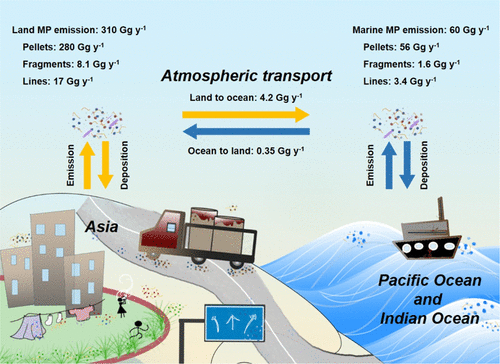Difference between revisions of "Papers:Long et al 2022"
From atmoschem
(Created page with "'''Abstract |''' We developed a regional atmospheric transport model for microplastics (MPs, 10 μm to 5 mm in size) over Asia and the adjacent Pacific and Indian oceans, acco...") |
|||
| Line 1: | Line 1: | ||
| + | [[Image:MP_conceptual.gif|center|500px|Atmospheric transport of microplastic between Asia and its adjacent oceans.]] | ||
| + | |||
'''Abstract |''' We developed a regional atmospheric transport model for microplastics (MPs, 10 μm to 5 mm in size) over Asia and the adjacent Pacific and Indian oceans, accounting for MPs’ size- and shape-dependent aerodynamics. The model was driven by tuned atmospheric emissions of MPs from the land and the ocean, and the simulations were evaluated against coastal (n = 19) and marine (n = 56) observations. Our tuned atmospheric emissions of MPs from Asia and the adjacent oceans were 310 Gg/y (1 Gg = 1 kton) and 60 Gg/y, respectively. MP lines and fragments may be transported in the atmosphere >1000 km; MP pellets in our model mostly deposited near-source. We estimated that 1.4% of the MP mass emitted into the Asian atmosphere deposited into the oceans via atmospheric transport; the rest deposited over land. The resulting net atmospheric transported MP flux from Asia into the oceans was 3.9 Gg/y, twice as large as a previous estimate for the riverine-transported MP flux from Asia into the oceans. The uncertainty of our simulated atmospheric MP budget was between factors of 3 and 7. Our work highlighted the impacts of the size and morphology on the aerodynamics of MPs and the importance of atmospheric transport in the source-to-sink relationship of global MP pollution. | '''Abstract |''' We developed a regional atmospheric transport model for microplastics (MPs, 10 μm to 5 mm in size) over Asia and the adjacent Pacific and Indian oceans, accounting for MPs’ size- and shape-dependent aerodynamics. The model was driven by tuned atmospheric emissions of MPs from the land and the ocean, and the simulations were evaluated against coastal (n = 19) and marine (n = 56) observations. Our tuned atmospheric emissions of MPs from Asia and the adjacent oceans were 310 Gg/y (1 Gg = 1 kton) and 60 Gg/y, respectively. MP lines and fragments may be transported in the atmosphere >1000 km; MP pellets in our model mostly deposited near-source. We estimated that 1.4% of the MP mass emitted into the Asian atmosphere deposited into the oceans via atmospheric transport; the rest deposited over land. The resulting net atmospheric transported MP flux from Asia into the oceans was 3.9 Gg/y, twice as large as a previous estimate for the riverine-transported MP flux from Asia into the oceans. The uncertainty of our simulated atmospheric MP budget was between factors of 3 and 7. Our work highlighted the impacts of the size and morphology on the aerodynamics of MPs and the importance of atmospheric transport in the source-to-sink relationship of global MP pollution. | ||
'''Publication |''' '''Long, X.''', '''Fu, T.-M.*''', Yang, X., Tang, Y., Zheng, Y., Zhu, L., Shen, H., Ye, J., Wang, C., Wang, T., Li, B. (2022), Efficient atmospheric transport of microplastics over Asia and adjacent oceans, ''Enviornmental Science & Technology'', 56(10), 6243–6252, doi:10.1021/acs.est.1c07825.[https://pubs.acs.org/doi/10.1021/acs.est.1c07825 Full text]. | '''Publication |''' '''Long, X.''', '''Fu, T.-M.*''', Yang, X., Tang, Y., Zheng, Y., Zhu, L., Shen, H., Ye, J., Wang, C., Wang, T., Li, B. (2022), Efficient atmospheric transport of microplastics over Asia and adjacent oceans, ''Enviornmental Science & Technology'', 56(10), 6243–6252, doi:10.1021/acs.est.1c07825.[https://pubs.acs.org/doi/10.1021/acs.est.1c07825 Full text]. | ||
Latest revision as of 12:20, 15 June 2022
Abstract | We developed a regional atmospheric transport model for microplastics (MPs, 10 μm to 5 mm in size) over Asia and the adjacent Pacific and Indian oceans, accounting for MPs’ size- and shape-dependent aerodynamics. The model was driven by tuned atmospheric emissions of MPs from the land and the ocean, and the simulations were evaluated against coastal (n = 19) and marine (n = 56) observations. Our tuned atmospheric emissions of MPs from Asia and the adjacent oceans were 310 Gg/y (1 Gg = 1 kton) and 60 Gg/y, respectively. MP lines and fragments may be transported in the atmosphere >1000 km; MP pellets in our model mostly deposited near-source. We estimated that 1.4% of the MP mass emitted into the Asian atmosphere deposited into the oceans via atmospheric transport; the rest deposited over land. The resulting net atmospheric transported MP flux from Asia into the oceans was 3.9 Gg/y, twice as large as a previous estimate for the riverine-transported MP flux from Asia into the oceans. The uncertainty of our simulated atmospheric MP budget was between factors of 3 and 7. Our work highlighted the impacts of the size and morphology on the aerodynamics of MPs and the importance of atmospheric transport in the source-to-sink relationship of global MP pollution.
Publication | Long, X., Fu, T.-M.*, Yang, X., Tang, Y., Zheng, Y., Zhu, L., Shen, H., Ye, J., Wang, C., Wang, T., Li, B. (2022), Efficient atmospheric transport of microplastics over Asia and adjacent oceans, Enviornmental Science & Technology, 56(10), 6243–6252, doi:10.1021/acs.est.1c07825.Full text.
- This page was last modified on 15 June 2022, at 12:20.
- This page has been accessed 606 times.
